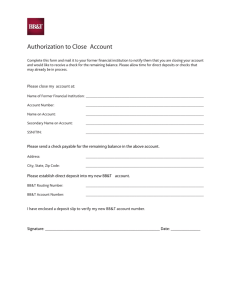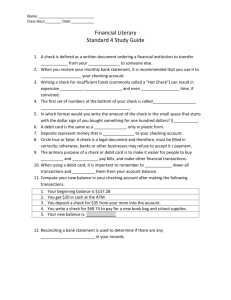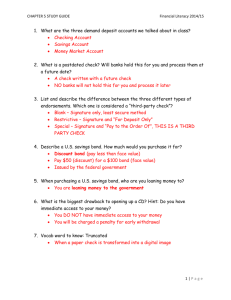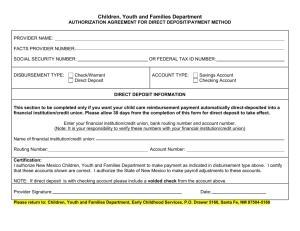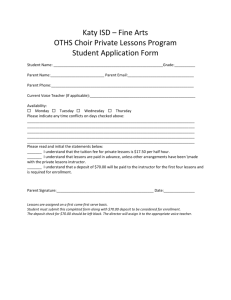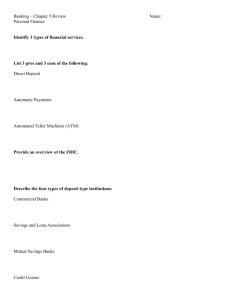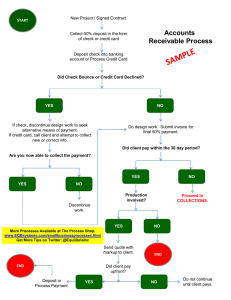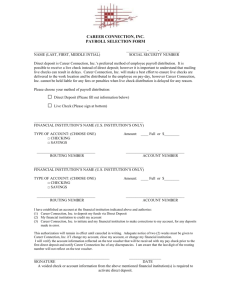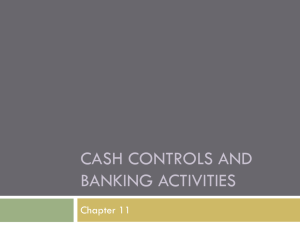Financial Services and Institutions
advertisement
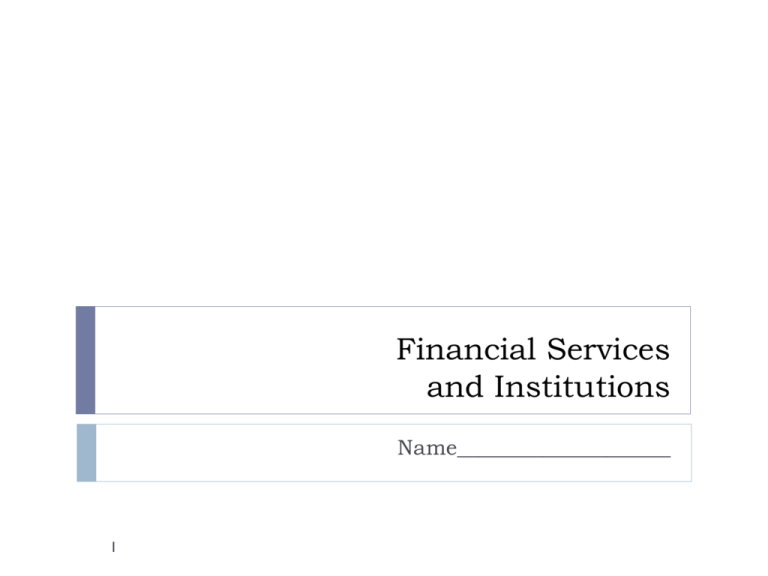
Financial Services and Institutions Name____________________ 1 How to Manage Your Cash What are your cash needs? Banking began in 1791 – 1 central bank with 8 branches Today – 11,000 _________ 2,000 _____________________ 12,000 ____________________ Types of Financial Services Savings – safe storage of funds Time Deposit – money left in the bank for months/yrs Payment Services – transferring money from a personal account to businesses or individuals for payment is a basic function of day-today financial activity at a bank. 2 ____________________ Certificates of Deposit (CD’s) Checking account – ___________________– withdraw money at any time or on demand Types of Financial Services (cont) Borrowing – need to borrow money Short term – credit cards, personal loan _____________– Other Financial Services 3 mortgage – for a house Auto loan – for a car _____________________ Stocks, bonds, mutual funds, income tax assistance, financial planning Electronic Banking Services How can you use electronic banking services? Direct Deposit – automatic deposit of net pay to an employee’s designated bank account Save time money and effort ______________________ Automatic Payments – Utility companies, lenders and other businesses allow customers to use an automatic payment system ____________________________ Automated Teller Machines (ATMs) – cash machine, computer terminal that allows a withdrawal of cash from an account…make deposits…transfer money from one acct. to another Debit card…allows you to use ATM or pay for purchases from checking/savings 4 PIN – _________________– needed to access and use your debit card Plastic Payment ATM Fees – convenience fee for using the card Lost – must notify bank ___________…most card issuers will not hold you responsible Point-of-Sale Transactions – purchase by a debit card of a good/service at a retail store, restaurant. _______________ ________________________________ Stored-Value Cards – Prepaid cards that you can use for bus, school lunches, long-distance phone calls ________________________ Electronic Cash – plan is to create electronic versions of all existing payment systems, will no longer handle currency 5 Types of Financial Institutions Federal Deposit Insurance Corporation Great Depression of the 1930’s People lost their deposits _______________________ Protect deposits - $100,000 (Federally Chartered Banks) Currently at ________________(Due to expire Dec 2013) Deposit Institutions – deposit type institutions Commercial Banks ______________institution that offers a full range of financial services…checking…savings…lending 6 Individuals and businesses Types of Financial Institutions Savings and Loan Associations (S&L) – traditionally specializes in savings accounts and mortgage loans The Savings and Loans Crisis created the greatest banking collapse since the Great Depression of 1929. By 1989, over half the Savings and Loans had failed Mutual Savings Banks Credit Unions – non-profit financial institution that is owned by its members and organized for their benefit ______________________ College Alumni Assoc Non-Deposit Institutions 7 ______________________ Investment Companies ______________________ Mortgage Companies Problematic Financial Businesses Be careful of these financial businesses 8 ________________________ Check Cashing Outlet ________________________ Rent-to-Own Centers Comparing Financial Institutions Where can you get the highest interest rate for your savings ________________________________ Offer of credit cards or loans Do they offer free financial advice ____________________________ Convenient branch locations 9 Savings Plans and Payment Methods Regular Savings Accounts Passbook or monthly or quarterly statements Frequent deposits and withdrawals ______________________________ Lower interest rates Certificates of Deposit (CD) savings alternative in which money is left on deposit for a stated period of time to earn a specific rate of return Low risk _____________________________ 10 Trade-off: 1 month to 5 yrs, pay penalty for early withdrawal, minimum deposit Maturity date – _________________________________ Savings Plans and Payment Methods Money Market Accounts – savings account that requires a minimum balance and earns interest that varies from month to month Minimum balance of _____, penalty for below minimum Write a limited amount of checks _________________________ U.S. Savings Bonds - bonds require that you leave the money in the account for a longer period of time. You purchase the bond at one half its face value. If you cash in the bond before that time, you will not receive the whole value of the bond. 11 ____________________________ Evaluating Savings Plans Rate of Return (yield) – percentage of increase in the value of your _____________________________ Example – Initial deposit $75, $3 interest earned…the rate of return is 4% Total interest/initial deposit (3 divided 75 = .04 (4%) Compounding – is the process in which interest is earned on both the principal, the original deposit, and any previously earned interest Truth in Savings – have to inform you of the following: 12 ___________________________ Interest Rate Annual percentage yield (APY) Term and conditions of the savings plan Evaluating Savings Plans Annual Percentage yield (APY) – the amount of interest that a deposit would earn, after compounding, for one year. _____________________________________ The APY helps your determine the amount you can expect to earn on your money Liquidity – Check the savings plans you are considering to determine whether they charge a penalty or pay a lower rate if interest if you withdraw your funds early. 13 Types of Checking Accounts Regular Checking Accounts – usually do not require a __________________________ Activity Accounts – write few checks, will be charged per check and deposit Interest-Earning Checking Account – combination checking/savings…pay interest if minimum balance is kept 14 Evaluating Checking Accounts Restrictions – is there a _________ balance requirement Fees and Charges – monthly service charge, fees for check printing, overdrafts, stop payment orders Interest – Interest rates, frequency of compounding Special Services – 15 ATM Electronic banking Overdraft protection – automatic loan made to an account if the balance will not cover checks written Using a Checking Account How do you open and use a checking account? Individual – ____________________ Joint – two or more owners Signature Card – ________________________ Writing Checks 16 Check Register – small booklet that you use to record your activity Record in check register – date, number of check, name of party who will receive payment, exact amount of check Record all checks, deposits, ATM activity Making a Deposit To add money to your checking account, fill out a deposit slip 17 Endorsements Signature of payee, the party to whom the check has been written. Blank Endorsement – payee signature on back of check Restrictive Endorsement – check holder’s signature and a restriction on how the paper may be used by the bank Write “For Deposit Only” and then you sign your name Special Endorsement – allows you to transfer a check to an organization or another person 18 Sign your name Write the words “pay to the order of” followed by the name of the organization or person, and then you sign your name Endorsements 19 1. 2. 3. Endorsing a check: Do not endorse a check until you are ready to ____________________________ Write your signature on the back of the check at the top ______________________ Sign your name exactly as it appears on the front of the check Use a _______ so that the signature cannot be erased If depositing, write, “For Deposit Only” above your signature Check Clearing – system that ensures that the money you deposited in the acct is available for withdrawal (2-5 days) 20 Keeping Track of a Checking Account Each month your bank will send you a statement that shows your checking account activity for the month __________________ Checks you have written (charged against your account) ____________________ Debit card charges (identified by the business to whom you made the payment) ___________________ Fees 21 Reconciliation Balance reported on the bank statement may be different from the balance in your check register Written checks that have not yet ____________________ Deposit money into your account after the bank prepared your statement ________________________ Interest paid Bank Reconciliation – report that accounts for the differences between the bank statement and a checkbook balance 22 Balancing your check book: Bank statement = checkbook Balancing your Checkbook Compare checks written in checkbook to bank statement (ck#-101,102,103-stmt-101,102) 1. Outstanding checks – checks you have written that haven’t cleared the bank (103) Subtract total amount of outstanding cks from bank statement balance Determine whether any recent deposits are not on the bank statement 2. 3. 4. 23 Add amounts of those deposits to the bank statement Subtract fees and charges listed on the statement from your checkbook balance Add interest earned to your checkbook balance Checkbook=Bank Statement Other Payment Methods Certified check – personal check with a guaranteed payment – deducts amount out of your account immediately – fee charged Cashiers Check – ___________________________ Money Order – pay the amount of the check + fee (also can be purchased at ___________for a smaller fee) Travelers Check – used for traveling, can be replaced if stolen (amount + fee) 24 How Do Banks Make Money? Banks make money by making loans Federal Reserve sets a reserve requirement 3%-10% for each deposit the rest can be loaned out 25 You deposit $100, the bank can loan out $90 (if reserve is 10%)
